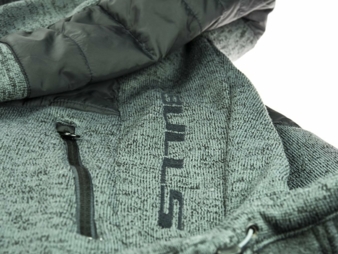28/03/2019 – Madeira Garnfabrik — auf Deutsch lesen
Embroidering stretchy functional clothing?
Smooth surface and high flexibility often pose challenges for embroiderers. How to succeed an ideal embroidery result?
Whether ultra-light, breathable or water-repellent – functional fabrics differ greatly in their properties from conventional textiles. They must be windproof, thermo-regulating, dirt-repellent or UV-resistant to protect their wearers against environmental influences or to support them during sports activities. However, for garment manufacturers, textile finishers and embroiderers, the special properties of the materials can be challenging. Especially during the embroidery process, high-tech materials tend to pucker or stretching due to their smooth surface. Due to the stretchiness of the fabric, the finished embroidery can lose its shape and incorrectly selected needles quickly lead to material damage. Although there is no patented remedy for guaranteed perfect embroidery results, with the right adjustment and planning, the ideal result can be achieved. The programming should always be adapted to the fabric, and the right embroidery thread, the right needle and a suitable stabiliser should be chosen.
Customisation – the key to success for embroidery on thin, high-tech textiles
Wrinkling and hard, inflexible embroideries are common problems when embroidering flexible and stretchy fabrics. The following adjustments in the digitisation can help to achieve even results:
• Especially around corners and curves in lettering and small details, the stitch density should be reduced.
• Lightweight underlay stitches help to stabilise the shape of the embroidery.
• Stitch directions that run slightly diagonally to the warp and weft threads of the fabric prevent puckering.
• Starting in the middle of the design, instead of working from left to right, helps protect the fabric and to optimise the result.
Thread recommendations for embroidered sports and performance wear
If you want to realise soft embroidery on high-tech textiles, you should first select a suitable thread in the right weight. With the appropriate embroidery thread, the wearing comfort of the garment also increases noticeably. In general, the thinner the fabric, the finer the thread.
The following threads and thread weights are particularly suitable for embroidering functional textiles:
• Fine but resistant polyester threads with dtex 168 (84x2) , dtex 110 (55x2) or dtex 180 (90x2)
• Silky and shiny viscose threads with dtex 168 (84x2)
Fine embroidery needles for better results on tightly woven fabrics
Whenever the needle penetrates the material’s structure, fibres shift and the fabric warps. By using thin needles, puckering can be reduced. Needles with size NM 60 or NM 70 are particularly suitable for functional fabrics. The shape of the needle tip is crucial to prevent damage to the material. While slightly rounded tips (such as RG or FFG ) displace the fabric without damaging it, regular round-pointed needles can destroy the fibres. Titanium-coated needles have less mechanical vibration and are ideal for high-precision punctures. They can also be used to produce refined embroidery results on smooth and extra-firm fabrics such as caps, bags and shoes.
Backings and toppings for optimal hold
When embroidering functional textiles, it is recommended to use lightweight cut-away backings with 30-55 g/m². A structured backing creates an additional advantage, as it does not show through light textiles. Additionally, the usage of a water-soluble embroidery topping reinforces the top of the embroidery and prevents the stitches from sinking into the fabric. Furthermore, the use of toppings supports the stitch constructions of filigree details and lettering and visibly improves the quality of the embroidery.
Stabilisers for embroidery on functional fabrics
• Textured backings are soft and supple and continue to preserve the embroidery even after several washes.
• Water-soluble toppings help to achieve a clean embroidery result with clear contours.
Tip 1: When clamping the garment, tension on the fabric should be avoided to prevent wrinkles on the base fabric.
Tip 2: While the embroidered section is still in the frame, the excess backing can easily be cut away with a seam ripper so you get a clean finish on the back of the embroidery.
Lucie Schaal, Madeira Garnfabrik





